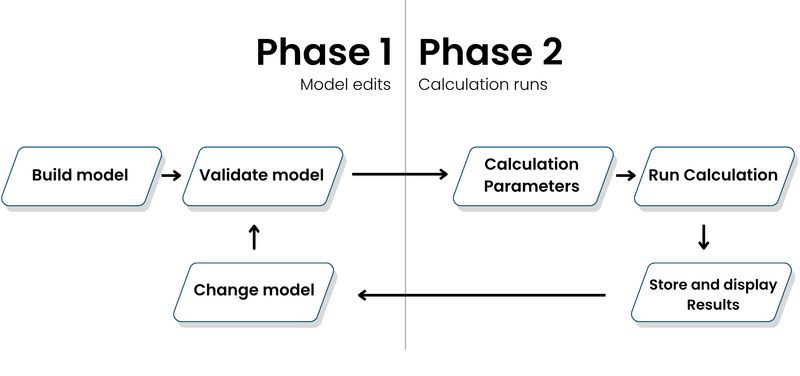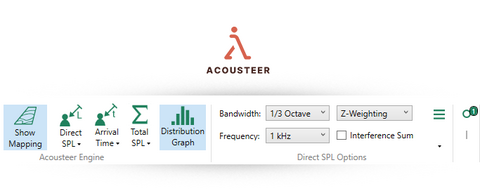The real-time revolution: How EASE 5’s Acousteer engine is pioneering a new, unified era of acoustic design

When AFMG released EASE 5 Third Edition in late 2024, it introduced a feature that represented not just an update, but a fundamental reinvention of the acoustic simulation workflow: the Acousteer engine. Initially presented as a tool for real-time mapping of direct sound coverage, Acousteer has undergone a remarkable and rapid evolution in just one year. A series of methodical, feature-rich updates have transformed it from an innovative visualization tool to a comprehensive, integrated suite for sound system design, and now it is stepping into a powerful engine for predictive room acoustics. This evolution signals a deliberate move toward a holistic design environment where the loudspeaker system and the room are no longer treated as separate entities, but as an interconnected system, simulated with unprecedented speed and interactivity.
The paradigm shift: From "calculate and wait" to "design at the speed of thought"

Before the introduction of Acousteer, the established workflow for acoustic consultants and system designers was a slow, two-step process. First, a model was carefully created, the loudspeakers were positioned and aligned, and then a calculation was initiated. This often meant a significant wait of some seconds to minutes while the simulation rendered a static map of the sound coverage. Any subsequent change, a minor adjustment to the loudspeaker angle, a change in the EQ setting, or the addition of a front fill, required repeating the entire process. While precise, this iterative cycle represented a significant bottleneck for creativity and efficiency, often discouraging fine-tuning and experimentation.
The release of EASE 5 Third Edition with Acousteer in November 2024 (v5.68) broke this paradigm. Thanks to a highly optimized hybrid CPU/GPU simulation engine, Acousteer fulfilled a long-held practitioner’s dream: the ability to instantly see the results of design decisions. Designers could now move a loudspeaker, adjust its dispersion angle, or change its gain while watching the direct SPL map for the audience areas update in real time. This immediate visual feedback transformed the design process from a static, predictive exercise into a dynamic, interactive experience, much like live audio mixing.

The first version supported the full audio bandwidth from 20 Hz to 20 kHz, used high-resolution, complex-valued GLL loudspeaker data for maximum accuracy, and enabled various spatial resolutions. This was not only a faster way of working, but a completely new approach. SPL coverage issues could be identified and resolved in seconds rather than hours. The interplay between the various elements of a sound system became immediately apparent, promoting a more intuitive understanding of complex acoustic interactions.
Sharpening the tools for system design
Following the introduction of Acousteer, AFMG launched a series of rapid updates to further develop the program into a robust and accurate tool for the most demanding system design tasks.
The initial improvements focused on replacing purely visual representation with in-depth analysis. In December 2024, version 5.69 introduced A and C rating, allowing developers to view sound pressure level (SPL) maps in a way that better corresponds to human hearing perception. In addition, the useful mapping read-out function was added, which shows the exact SPL value at the mouse pointer position, thus providing immediate quantitative data without the need for a separate report.
Version 5.70, released in January 2025, was an important update for detailed analysis. The introduction of isolines enabled designers to visualize the uniformity of sound coverage in specific decibel ranges. Instead of a smooth color gradient, the map could now be displayed as contour lines, making it easy to verify whether a design goal, such as +/- 3 dB across a seating area, had been achieved. This update also included the ability to export the entire sound system configuration as an XLD text file, an important feature for interoperability with other platforms, from immersive systems and manufacturer aiming software to environmental noise solutions.
The workflow itself was the focus of version 5.71, released in February 2025. This version introduced simulation configurations, a powerful feature that allowed users to save and recall entire sets of calculation and display parameters. Designers could now create different configurations for analyzing low-frequency coverage, loudspeaker choices, or different weighting models and switch between them with a single click. This enabled direct and time-saving A/B comparisons of different design strategies, making Acousteer a powerful tool for comparative analysis.
Acousteer's development into a leading system design tool reached a new peak in May 2025 with version 5.73. This version expanded the engine's capabilities beyond SPL calculation to include time-of-flight calculation. The new arrival time map visualized the delay time from the sound system to the listener in real time, taking into account both the delay time and any delays caused by electronic filters. This revolutionized the development and optimization of delay systems. The alignment of delay towers, front fills, and under-balcony speakers became an interactive process in which shifting arrival times could be observed in real time. The feature even included an option to activate the precedence effect, allowing designers to verify that the listener's perception of sound localization was correctly aligned with the primary sound source.
Further improvements were made over the course of the summer. Version 5.74, released in June, added the distribution chart, a real-time histogram that statistically breaks down coverage in different audience areas and shows the percentage of the audience receiving sound in specific level ranges, now responsive in real-time. This provided a quick statistical overview of system performance. Just one month later, version 5.75 added another layer of physical realism by integrating shadow effects. Acousteer now took into account surfaces and objects that blocked the line of sight between the sound source and the listener and updated the maps accordingly.
Bridging the divide: The expansion into room acoustics
While Acousteer revolutionized the development of sound reinforcement systems, room acoustics—the other half of the acoustic equation—remained primarily the domain of traditional, slower calculation modules. However, a series of updates at the end of 2025 revealed AFMG's ambitious plan: to integrate room acoustics directly into Acousteer's real-time engine.
The foundation for this was laid with version 5.76 in September 2025. This update significantly expanded the software's basic acoustic parameters. The frequency range for acoustic materials and general parameters was extended to 25 Hz to 20 kHz. Even more important was the introduction of two central room acoustic concepts into the user interface: the Schroeder frequency and the calculated reverberation level. For the first time, the software was able to display the frequency below which the room response is dominated by modal resonances and calculate the overall level of the diffuse reverberant field based on Eyring statistics. This was a clear signal that the contribution of the room was being brought to the fore.
This endeavor continued with release of version 5.77 on October 30, 2025. This significant update introduced a new, comprehensive metric to the Acousteer engine: real-time simulation of the overall sound pressure level (Total SPL). The display no longer showed only the direct sound from the loudspeakers, but now calculated and visualized the total sound energy as the sum of direct sound and sound energy reverberating in the room. Based on the Eyring-Norris equation for reverberation time, this new display provides an interactive live view of how the energy of the sound system affects the acoustic space and contributes to the overall sound volume perceived by the listener.
This is a fundamental advancement. Designers can now change the absorption coefficient of a wall material and immediately observe the effects on the overall sound pressure level throughout the room. They can see in real time how adjusting the directivity of a loudspeaker array affects not only the direct coverage but also the energy emitted into the reverberant space.
The future is an integrated acoustic ecosystem

Within just twelve months, Acousteer has evolved from a specialized real-time tool into a versatile simulation platform. Each update was a deliberate step toward a more holistic and integrated design process. Development began with interactive field analysis, followed by quantitative and temporal analyses and now continues with the integration of the room itself.
Demonstrating a consistent commitment to robustness and future-proofing, continuous bug fixes based on user reports, performance improvements, support for new hardware such as Nvidia 50-series graphics cards, and updates to core frameworks such as the .NET SDK point to a platform designed for long-term use.
The trend is clear: Acousteer is evolving into a comprehensive real-time acoustic simulation suite that will allow every aspect of a sound system's performance and its interaction with the listening room to be modeled, visualized, and optimized with an ease that was a dream just a year before. The boundaries between electro- and room acoustics in a real-time environment are blurring, and EASE 5’s Acousteer engine is setting the tone.
Experience the new workflows enabled by Acousteer for yourself. Get the Free Trial.
Curious about how Acousteer came to be? Take a look at the audioXpress article about its conception.